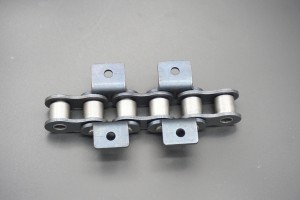What is the difference between the A Series and B Series roller chains?
Roller chains are essential components in modern industrial transmission systems and are widely used in various mechanical equipment. Based on different standards and application scenarios, roller chains are mainly divided into the A Series and B Series.
I. Standards and Origins
A Series: Conforms to the American Standard for Chains (ANSI), the primary standard in the US market, and is widely used in North America.
B Series: Conforms to the European Standard for Chains (ISO), primarily based in the UK, and is widely used in Europe and other regions.
II. Structural Features
Inner and Outer Link Plate Thickness:
A Series: The inner and outer link plates are of equal thickness, achieving uniform static strength through different adjustments.
B Series: The inner and outer link plates are of equal thickness, achieving uniform static strength through different swinging motions.
Component Size and Pitch Ratio:
A Series: The main dimensions of each component are proportional to the pitch. For example, pin diameter = (5/16)P, roller diameter = (5/8)P, and chain plate thickness = (1/8)P (P is the chain pitch).
B Series: The main component dimensions are not clearly proportional to the pitch.
Sprocket Design:
A Series: Sprockets without bosses on both sides.
B Series: Drive pulleys with a boss on one side, secured with a keyway and screw holes.
III. Performance Comparison
Tensile Strength:
A Series: In the eight pitch sizes of 19.05 to 76.20 mm, the tensile strength is greater than that of the B Series.
B Series: In the two pitch sizes of 12.70 mm and 15.875 mm, the tensile strength is greater than that of the A Series.
Chain Length Deviation:
A Series: Chain length deviation is +0.13%.
B Series: Chain length deviation is +0.15%. Hinge Pair Support Area:
A Series: Offers the largest support area of the 15.875 mm and 19.05 mm pitch sizes.
B Series: Offers a 20% larger support area than the A Series with the same inner link width.
Roller Diameter:
A Series: Each pitch has only one roller size.
B Series: Roller diameter is 10%-20% larger than the A Series, with two roller widths available for each pitch.
IV. Application Scenarios
A Series:
Features: Suitable for medium-load and low-speed transmission systems.
Applications: Widely used in construction machinery, agricultural machinery, automotive manufacturing, metallurgy, petrochemicals, and other industries.
B Series:
Features: Suitable for high-speed motion, continuous transmission, and heavy loads.
Applications: Primarily used in industrial machinery, metallurgical machinery, textile machinery, and other applications.
V. Maintenance and Care
A Series:
Tensioning: Tension sag = 1.5%a. Exceeding 2% increases the risk of tooth skipping by 80%.
Lubrication: Suitable for high-temperature environments, use graphite grease.
B Series:
Tensioning: Tension sag = 1.5%a. Exceeding 2% increases the risk of tooth skipping by 80%.
Lubrication: Suitable for salt spray corrosion environments, use Dacromet-coated chain plates and lubricate quarterly.
VI. Selection Recommendations
Choose based on the application scenario: If your equipment needs to operate under medium loads and low speeds, the A Series may be a better choice; if it requires high speeds, continuous transmission, and heavy loads, the B Series is more suitable.
Consider maintenance costs: There are some differences in maintenance between the A and B Series. When choosing, consider the equipment’s operating environment and maintenance resources.
Ensure compatibility: When selecting a chain, ensure that the pitch of the chain and sprocket are consistent to avoid transmission issues.
Post time: Aug-08-2025

